
Marylebone station is a Central London railway terminus and connected London Underground station in the Marylebone area of the City of Westminster. On the National Rail network, it is also known as London Marylebone and is the southern terminus of the Chiltern Main Line to Birmingham. An accompanying Underground station is on the Bakerloo line, sited between Edgware Road and Baker Street stations in Transport for London's fare zone 1.
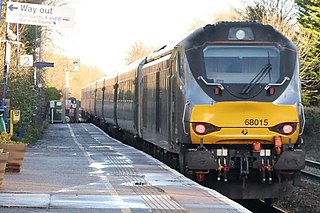
Chiltern Railways is a British train operating company that has operated the Chiltern Railways franchise since July 1996. Since 2009, it has been a subsidiary of Arriva UK Trains.

The British Rail Class 121 is a single-car double-ended diesel multiple unit. 16 driving motor vehicles were built from 1960, numbered 55020–55035. These were supplemented by ten single-ended trailer vehicles, numbered 56280–56289. They have a top speed of 70 mph (113 km/h), with slam-doors, and vacuum brakes. The driving motor vehicles were nicknamed "Bubble Cars" by some enthusiasts.
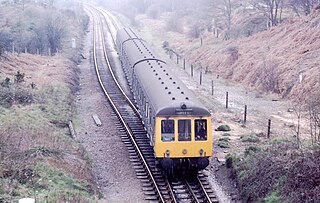
The British Rail Class 116 diesel multiple units were built by BR Derby from 1957 to 1961. Introduced as part of the British Railways Modernisation Plan in the mid 1950s, as with other first generation DMUs the 116 was intended to replace steam trains and reduce costs across the rail network. Alongside Metro-Cammell, BR Derby had prior experience with DMUs, having developed a Lightweight Unit, and so was awarded a contract for a new design.

The British Rail Derby Lightweight diesel multiple units, were the first such trains to be built en-masse for British Railways. The units were built at BR's Derby Works from 1954 to 1955. The units were built in various formations, including 12 power-twin 2-car units, 84 power-trailer 2-car units, four 4-car units, and two single car units.

The British Rail Class 127 diesel multiple units were built by BR Derby in 1959. Thirty 4-car units were built, formed of two outer driving motor vehicles, sandwiching two intermediate trailers which were classified class 186. The technical description of such as 4-car unit was DMBS + TSL + TS + DMBS.

The British Rail Class 165 Networker Turbo is a fleet of suburban diesel-hydraulic multiple unit passenger trains (DMUs), originally specified by and built for the British Rail Thames and Chiltern Division of Network SouthEast. They were built by BREL York Works between 1990 and 1992. An express version was subsequently built in the form of the Class 166 Networker Turbo Express trains. Both classes are now referred to as "Networker Turbos", a name derived some three years later for the project that resulted in the visually similar Class 365 and Class 465 EMUs.

Denham Golf Club railway station is a railway station near the villages of Baker's Wood and Denham, Buckinghamshire, England. The station is on the Chiltern Main Line between Denham and Gerrards Cross.

The Chiltern Main Line is a railway line which links London (Marylebone) and Birmingham on a 112-mile (180 km) route via High Wycombe, Bicester, Banbury, Leamington Spa and Solihull in England.

Aylesbury railway station is a railway station in Aylesbury, Buckinghamshire, England, on the London–Aylesbury line from London Marylebone via Amersham. It is 38 miles (61 km) from Aylesbury to Marylebone. A branch line from Princes Risborough on the Chiltern Main Line terminates at the station. It was the terminus for London Underground's Metropolitan line until the service was cut back to Amersham in 1961. The station was also known as Aylesbury Town under the management of British Railways from c. 1948 until the 1960s.

The British Rail Class 118 diesel multiple units were built by the Birmingham Railway Carriage and Wagon Company (BRCW) and introduced from 1960. It was a licence-built version of the British Rail Class 116.
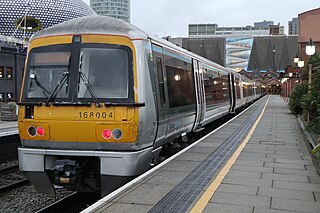
The Class 168 Clubman is a British diesel-hydraulic multiple unit passenger train used on Chiltern Line services between London Marylebone and the West Midlands. The trains were built by Adtranz at the Derby Litchurch Lane Works in several batches from 1998.

The London–Aylesbury line is a railway line between London Marylebone and Aylesbury, going via the Chiltern Hills; passenger trains are operated by Chiltern Railways. Nearly half of the line is owned by London Underground, approximately 16 miles (26 km) – the total length of the passenger line is about 39 miles (63 km) with a freight continuation.

Stoke Mandeville railway station serves the village of Stoke Mandeville, south of Aylesbury in Buckinghamshire, England. The station is on the London - Aylesbury line and is served by Chiltern Railways trains. It is between Wendover and Aylesbury stations.
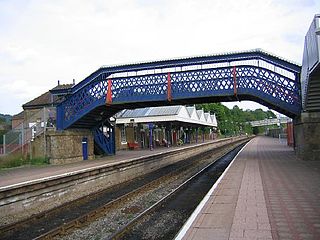
Wendover railway station serves the town of Wendover in Buckinghamshire, England, and villages including Ellesborough and Wendover Dean. The station is on the London Marylebone – Aylesbury line and is served by Chiltern Railways trains. It is between Great Missenden and Stoke Mandeville stations.

Great Missenden railway station serves the village of Great Missenden in Buckinghamshire, England and the neighbouring villages of Prestwood, Little Hampden and Little Missenden. The station lies on the London to Aylesbury Line and is served by Chiltern Railways trains. It is between Amersham and Wendover stations.
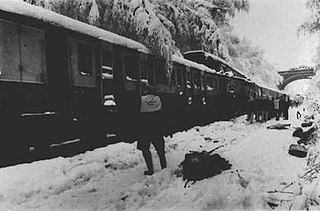
The Seer Green rail crash occurred on the morning of 11 December 1981 near Seer Green, Buckinghamshire, England between two four-car Class 115 diesel multiple units, killing one driver and three passengers.

Claydon railway station is a former railway station on the 'Varsity Line', that served the village of Steeple Claydon in Buckinghamshire.

The British Rail Class 172 is a British diesel multiple unit (DMU) passenger train from the Turbostar family, built by Bombardier Transportation's Derby Litchurch Lane Works for use on inner-suburban passenger services. The class is currently operated by West Midlands Railway.

A slam-door train or slammer is a set of diesel multiple units (DMUs) or electric multiple units (EMUs) that were designed before the introduction of automatic doors on railway carriages in the United Kingdom and other countries, which feature manually operated doors. The name came about because of the characteristic noise made by the passengers slamming the doors closed when the train was about to depart.






















